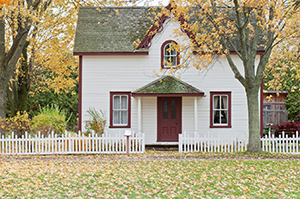
September Existing Home Sales Fall 2.2%

Existing home sales fell by 2.2 percent in September, following two consecutive months of increases, the National Association of Realtors reported yesterday.
NAR said total existing home fell from August to a seasonally adjusted annual rate of 5.38 million in September. Despite the decline, overall sales improved by 3.9% from a year ago (5.18 million).
Single-family home sales fell to a seasonally adjusted annual rate of 4.78 million in September, down from 4.91 million in August but up by 3.9% from a year ago. The median existing single-family home price rose to $275,100 in September, up 6.1% from a year ago. Existing condominium and co-op sales rose to a seasonally adjusted annual rate of 600,000 units in September, 1.7% above August and 3.4% higher than a year ago. The median existing condo price rose to $248,600 in September, an increase of 4.5% from a year ago.
All four regions saw sales declines, but rose or held steady from a year ago. Sales in the South decreased by 2.1% to an annual rate of 2.28 million in September but improved by 6.0% from a year ago. The median price in the South rose to $237,300, up 6.3% from one year ago. Sales in the West declined by 0.9% to 1.14 million in September, 5.6% higher than a year ago. The median price in the West rose to $403,600, up 4.5% from a year ago.
Sales in the Northeast fell by 2.8% to an annual rate of 690,000, a 1.5% rise from a year ago. The median price in the Northeast rose to $301,100, up 5.2% from a year ago. Sales in the Midwest fell by 3.1% to an annual rate of 1.27 million, unchanged from a year ago. The median price in the Midwest rose to $213,500, a 7.2% jump from a year ago.
The Realtor.com Market Hotness Index, measuring time-on-the-market data and listing views per property, showed the hottest metro areas in September were Fort Wayne, Ind.; Rochester, N.Y.; Pueblo, Colo.; Columbus, Ohio; and Topeka, Kan.
“Existing-home sales declined in September, but are running more than 7 percent ahead of last year’s sales pace, led by an almost 10 percent gain in the South, said Mike Fratantoni, Chief Economist with the Mortgage Bankers Association. “Home sales still remain constrained by a lack of inventory, with only 4.1 months of supply at the end of last month.”
Fratantoni said the combination of a strong job market and low mortgage rates continue to support housing demand as 2019 comes to a close. “Buyer interest is particularly robust among first-time homebuyers, who made up a third of sales last month,” he said. “Millennials’ interest in homeownership is strong, and should continue to support home sales growth heading into next year, given the low rate environment and still favorable economic conditions.”
Mark Vitner, Senior Economist with Wells Fargo Securities, Charlotte, N.C., said despite the pullback in sales, the overall trend remains positive.
“Despite the monthly drop, lower mortgage rates are providing a lift to the housing market, and resales are up 3.9% over the year,” Vitner said. “While buying conditions have improved, the continued lack of inventory on the market is likely limiting sales.”
NAR Chief Economist Lawrence Yun said despite historically low mortgage rates, sales have not commensurately increased, in part due to a low level of new housing options. “We must continue to beat the drum for more inventory,” Yunsaid. “Home prices are rising too rapidly because of the housing shortage, and this lack of inventory is preventing home sales growth potential.”
NAR reported the median existing home price for all housing types in September rose to $272,100, up 5.9% from a year ago ($256,900), marking 91 straight months of year-over-year gains. Total housing inventory at the end of September sat at 1.83 million, equal to August, but a 2.7% decrease from 1.88 million one year ago. Unsold inventory is at a 4.1-month supply at the current sales pace, up from 4.0 months in August and down from the 4.4-month figure recorded a year ago.
The report said properties typically remained on the market for 32 days in September, up from 31 days in August and even from a year ago. Forty-nine percent of homes sold in September were on the market for less than a month.
First-time buyers were responsible for 33% of sales in September, up from 31% in August and 32% recorded a year ago. As the share of first-time buyers rose, individual investors or second-home buyers purchased 14% of homes in September, unchanged from August but down from 16% a year ago. All-cash sales accounted for 17% of transactions in September, down from 19% in August and 21% a year ago.
Distressed represented 2% of sales in September, unchanged from August but down from 3% a year ago.
